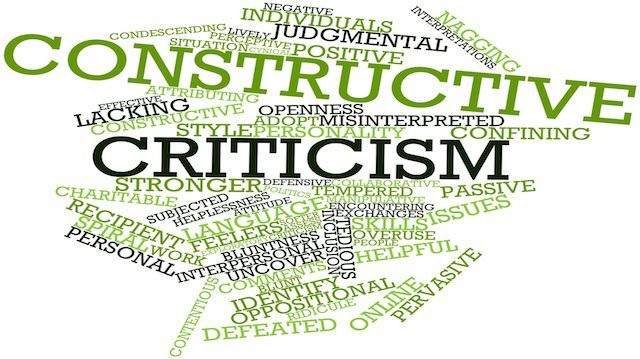
One of the hardest things in relationships is figuring out how to give or take criticism! It seems like everywhere you look there are people complaining about other people and wanting them to change. How do you tell someone they need to do better without offending them? And on the other side of the coin, what is the best way to deal with criticism when you receive it?
The obnoxious guy gets fired. The inexperienced person is given easy jobs where they will do the least damage but will never be eligible for a promotion. The clueless person doesn’t learn and continues to forge ahead on a destructive path without ever receiving guidance to reach their full potential.
In each case, a person could be helped, but either they are confronted in the wrong way and they get frustrated or defensive, or else no one tries to help because it is just too hard.
There is a proper way to handle confrontation and criticism. With a good plan, based on an understanding of how people think, you can learn how to give it and take it with poise and class.
Here are some good guidelines to giving criticism:
Step 1: Take a step back and think
Stop and think! It’s important to take a person’s feelings into consideration before you speak. Think of how you would react if someone said the same thing to you. This is not the whole solution, but it is a good start.
Before offering criticism, it’s also good to look at your motives. Do you care about the person? Now, I know you are probably thinking, why do I have to care about them?
Simply put, if you don’t care about a person, why would you want them to change anyway?
If you show a person that you truly care about them, they will respect you more, and they will want to listen to you because of the simple fact that people want to be cared about!
People want to feel important and appreciated, and if you are the one making them feel that way, they will love you for it.
When you foster an environment of respect and consideration, you will be surrounded by people who value your opinion. That makes offering constructive criticism so much easier.
Step 2: Don’t make statements. Ask questions
A judgemental attitude is the quickest way to make someone shut down or feel defensive. Listen to how different these two sentences are:
“Hey! You know you are doing that all wrong. Here’s how you do it the right way.”
“Hey! I could be wrong, but it looked like you were having some difficulty. Do you mind if I make a suggestion?
The first example is demeaning. It will either cause a person to get defensive and stop listening to you, or they will be shattered and lose confidence. Neither one is productive.
The second example gives a person some room and time to get used to the idea that they might need help. It’s clear that you are trying to help and not just putting them down.
Step 3: Make observations
Jumping right in with harsh judgments will make a person shut down. Offering help based on an observation gives a person the chance to take a step back and assess the situation.
You can say, “May I make an observation?” If they reply with a yes, then move on to, “It seemed to me that you were struggling with this.” If a person wants help, they may say, “Yeah, I was trying to do it this way but it doesn’t seem to be working very well.” In this scenario, two very good things have been accomplished.
First, a need for improvement has been established. This is very important because it means you don’t have to convince them that they were wrong. Second, they’re agreeing with you. This means they are not getting defensive and may be willing to accept help.
However, if the reply goes more like this, “No I’m fine, I don’t need any help,” then you have a problem on your hands. Sometimes, you can wait a while and approach the problem from a different angle. But if you continue to get the same result, then you may have to be more forceful.
Your approach does not have to be heavy-handed, but it must be concise. Now is not the time for beating around the bush: “I know you think everything is fine, but your work has not been up to standard and here is why.”
If they still do not respond well, it may be time to realize that the person is not teachable and that you are wasting your time. This is a hard call to make and should not be made quickly.
Step 4: Provide a solution
 Once you have established that there is a need for change, offer a solution that focuses on betterment rather than criticism of past mistakes. Providing a solution is far more constructive than giving a long lecture on why a person is underperforming. In all of this, remember to show them that you care and want to see them improve.
Once you have established that there is a need for change, offer a solution that focuses on betterment rather than criticism of past mistakes. Providing a solution is far more constructive than giving a long lecture on why a person is underperforming. In all of this, remember to show them that you care and want to see them improve.
So far we have concentrated on how to give criticism, but how do you receive it? The principles are the same — just put the shoe on the other foot.
How to take it like a man
Bear in mind that not all people are going to criticize you with this much grace and kindness. And you may have to grin and bear it.
Listen first, and then think before you react. You may not like the person or their message, but don’t miss out on the opportunity to grow and mature. The criticism may help you to do a better job in the future.
Take every criticism that comes your way as a useful tool. And if you show people that you are teachable, they will probably approach you more kindly. Remember this stuff goes both ways! Care about others, and others will care more about you!
—Kyle Kramer
Kyle is an outdoor enthusiast with a passion for nature and sustainability. When he is not writing, you will find him in his workshop crafting with local wood, hiking in the Arizona mountains, fly fishing, horseback riding or putting together a healthy meal in the kitchen.
Source:
http://www.artofmanliness.com/2008/11/04/how-to-give-and-take-criticism-like-a-man

